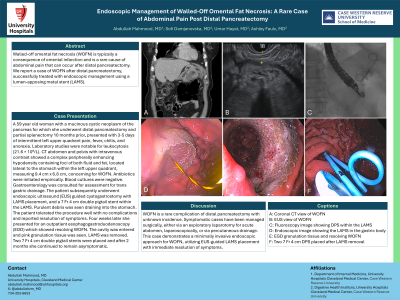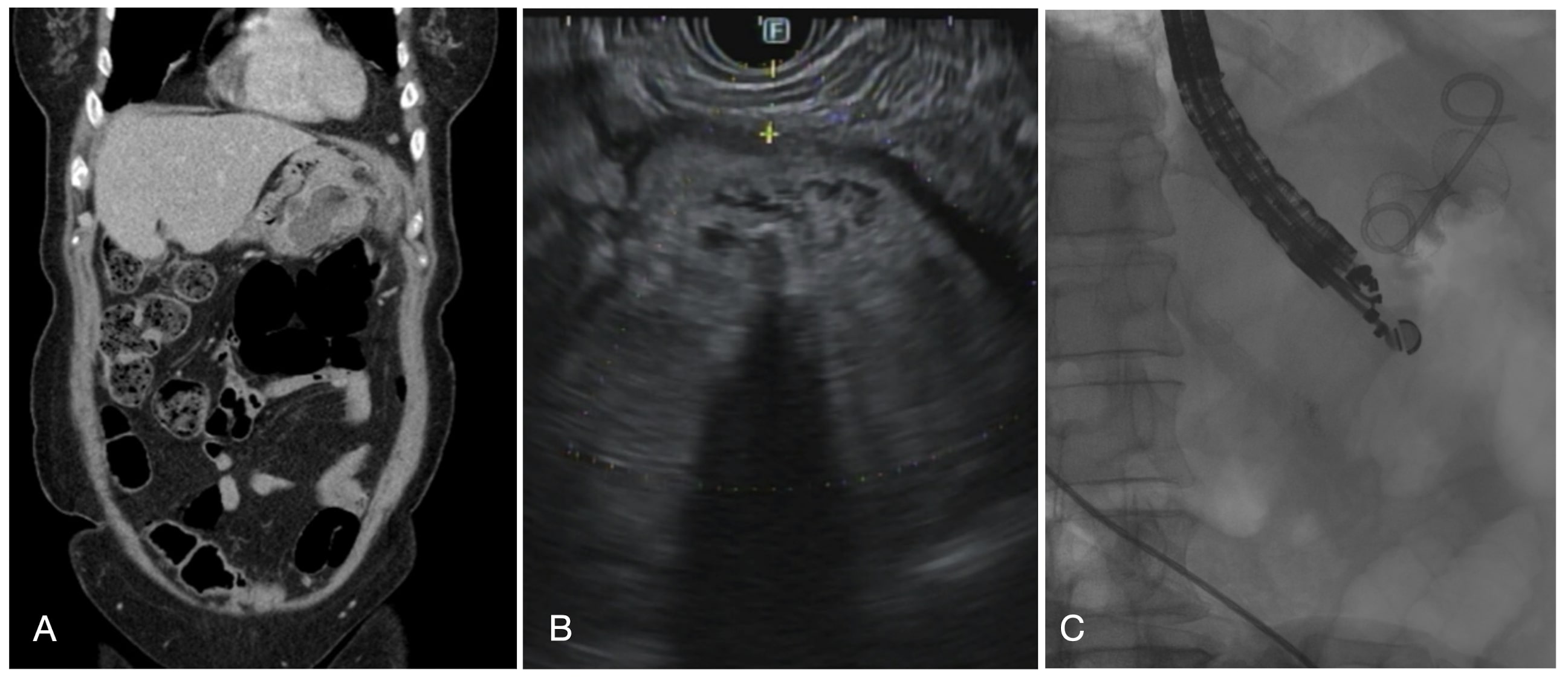Sunday Poster Session
Category: Interventional Endoscopy
P1112 - Endoscopic Management of Walled-Off Omental Fat Necrosis: A Rare Case of Abdominal Pain Post Distal Pancreatectomy
Sunday, October 27, 2024
3:30 PM - 7:00 PM ET
Location: Exhibit Hall E

Has Audio
.jpg)
Abdullah Mahmood, MD
University Hospitals Cleveland Medical Center, Case Western Reserve University
Cleveland, OH
Presenting Author(s)
Abdullah Mahmood, MD1, Sofi Damjanovska, MD1, Umar Hayat, MD2, Ashley Faulx, MD3
1University Hospitals Cleveland Medical Center, Case Western Reserve University, Cleveland, OH; 2DIgestive Health Institute, University Hospitals Cleveland Medical Center, Cleveland, OH; 3Digestive Health Institute, University Hospitals Cleveland Medical Center, Cleveland, OH
Introduction: Walled-off omental fat necrosis (WOFN) is typically a consequence of omental infarction, and is a rare cause of abdominal pain that can occur after abdominal surgeries, such as distal pancreatectomy. We report a case of WOFN occurring after a distal pancreatectomy, successfully treated with endoscopic management using a lumen-apposing metal stent (LAMS).
Case Description/Methods: A 59 year old woman with a past medical history of mucinous cystic neoplasm of the pancreas for which she underwent distal pancreatectomy and partial splenectomy 10 months prior, presented to our hospital with 3-5 days of intermittent left upper quadrant pain, fevers, chills, and anorexia. Laboratory studies were notable for leukocytosis to 21.6 × 109/L. CT abdomen and pelvis with intravenous contrast was remarkable for a complex peripherally enhancing hypodensity containing foci of both fluid and fat density, located lateral to the stomach within the left upper quadrant, measuring 9.4 x 6.8 cm, concerning for WOFN. Antibiotics were initiated empirically. Blood cultures were negative. Gastroenterology was consulted for assessment for transgastric drainage. The patient subsequently underwent endoscopic ultrasound (EUS) guided cystogastrostomy with LAMS placement, and 7 Fr 4 cm double pigtail stent within the LAMS. Purulent debris was seen draining into the stomach. The patient tolerated the procedure well with no complications and reported resolution of symptoms. Four weeks later she presented for an outpatient esophagogastroduodenoscopy (EGD) which showed resolving WOFN. The cavity was entered and pink granulation tissue was seen. LAMS was removed. Two 7 Fr 4 cm double pigtail stents were placed and after 2 months she continues to remain asymptomatic.
Discussion: WOFN is a very rare complication with unknown incidence. Symptomatic cases have been managed surgically, either via an exploratory laparotomy for an acute abdomen, laparoscopically, or via percutaneous drainage. This case demonstrates a minimally invasive endoscopic approach for WOFN, utilizing EUS-guided LAMS placement with immediate resolution of symptoms.

Disclosures:
Abdullah Mahmood, MD1, Sofi Damjanovska, MD1, Umar Hayat, MD2, Ashley Faulx, MD3. P1112 - Endoscopic Management of Walled-Off Omental Fat Necrosis: A Rare Case of Abdominal Pain Post Distal Pancreatectomy, ACG 2024 Annual Scientific Meeting Abstracts. Philadelphia, PA: American College of Gastroenterology.
1University Hospitals Cleveland Medical Center, Case Western Reserve University, Cleveland, OH; 2DIgestive Health Institute, University Hospitals Cleveland Medical Center, Cleveland, OH; 3Digestive Health Institute, University Hospitals Cleveland Medical Center, Cleveland, OH
Introduction: Walled-off omental fat necrosis (WOFN) is typically a consequence of omental infarction, and is a rare cause of abdominal pain that can occur after abdominal surgeries, such as distal pancreatectomy. We report a case of WOFN occurring after a distal pancreatectomy, successfully treated with endoscopic management using a lumen-apposing metal stent (LAMS).
Case Description/Methods: A 59 year old woman with a past medical history of mucinous cystic neoplasm of the pancreas for which she underwent distal pancreatectomy and partial splenectomy 10 months prior, presented to our hospital with 3-5 days of intermittent left upper quadrant pain, fevers, chills, and anorexia. Laboratory studies were notable for leukocytosis to 21.6 × 109/L. CT abdomen and pelvis with intravenous contrast was remarkable for a complex peripherally enhancing hypodensity containing foci of both fluid and fat density, located lateral to the stomach within the left upper quadrant, measuring 9.4 x 6.8 cm, concerning for WOFN. Antibiotics were initiated empirically. Blood cultures were negative. Gastroenterology was consulted for assessment for transgastric drainage. The patient subsequently underwent endoscopic ultrasound (EUS) guided cystogastrostomy with LAMS placement, and 7 Fr 4 cm double pigtail stent within the LAMS. Purulent debris was seen draining into the stomach. The patient tolerated the procedure well with no complications and reported resolution of symptoms. Four weeks later she presented for an outpatient esophagogastroduodenoscopy (EGD) which showed resolving WOFN. The cavity was entered and pink granulation tissue was seen. LAMS was removed. Two 7 Fr 4 cm double pigtail stents were placed and after 2 months she continues to remain asymptomatic.
Discussion: WOFN is a very rare complication with unknown incidence. Symptomatic cases have been managed surgically, either via an exploratory laparotomy for an acute abdomen, laparoscopically, or via percutaneous drainage. This case demonstrates a minimally invasive endoscopic approach for WOFN, utilizing EUS-guided LAMS placement with immediate resolution of symptoms.

Figure: A: Computed tomography (CT) view of walled-off omental fat necrosis (WOFN)
B: WOFN as shown on endoscopic ultrasound (EUS)
C: Fluoroscopy image showing a double pigtail stent (DPS) within a lumen-apposing metal stent (LAMS)
B: WOFN as shown on endoscopic ultrasound (EUS)
C: Fluoroscopy image showing a double pigtail stent (DPS) within a lumen-apposing metal stent (LAMS)
Disclosures:
Abdullah Mahmood indicated no relevant financial relationships.
Sofi Damjanovska indicated no relevant financial relationships.
Umar Hayat indicated no relevant financial relationships.
Ashley Faulx: Steris – Consultant.
Abdullah Mahmood, MD1, Sofi Damjanovska, MD1, Umar Hayat, MD2, Ashley Faulx, MD3. P1112 - Endoscopic Management of Walled-Off Omental Fat Necrosis: A Rare Case of Abdominal Pain Post Distal Pancreatectomy, ACG 2024 Annual Scientific Meeting Abstracts. Philadelphia, PA: American College of Gastroenterology.
